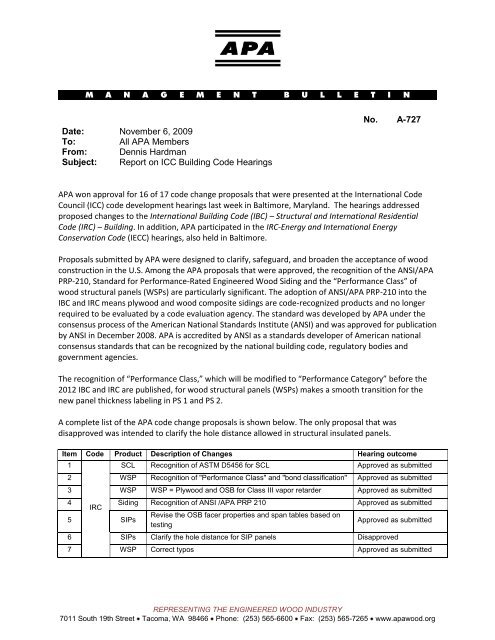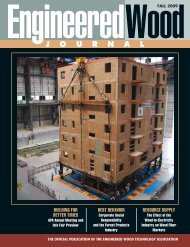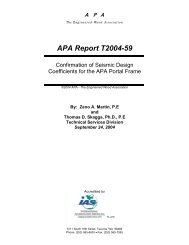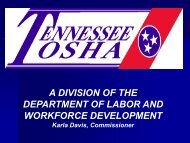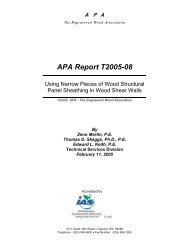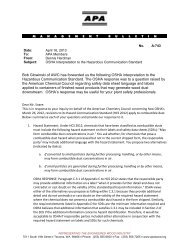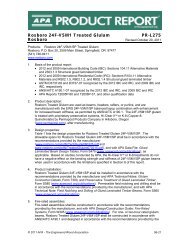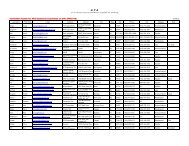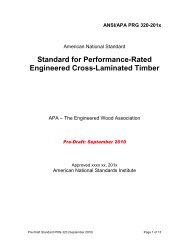marketing advisory committee memo - APA - The Engineered Wood ...
marketing advisory committee memo - APA - The Engineered Wood ...
marketing advisory committee memo - APA - The Engineered Wood ...
Create successful ePaper yourself
Turn your PDF publications into a flip-book with our unique Google optimized e-Paper software.
M A N A G E M E N T B U L L E T I NDate: November 6, 2009To: All <strong>APA</strong> MembersFrom: Dennis HardmanSubject: Report on ICC Building Code HearingsNo. A-727<strong>APA</strong> won approval for 16 of 17 code change proposals that were presented at the International CodeCouncil (ICC) code development hearings last week in Baltimore, Maryland. <strong>The</strong> hearings addressedproposed changes to the International Building Code (IBC) – Structural and International ResidentialCode (IRC) – Building. In addition, <strong>APA</strong> participated in the IRC-Energy and International EnergyConservation Code (IECC) hearings, also held in Baltimore.Proposals submitted by <strong>APA</strong> were designed to clarify, safeguard, and broaden the acceptance of woodconstruction in the U.S. Among the <strong>APA</strong> proposals that were approved, the recognition of the ANSI/<strong>APA</strong>PRP-210, Standard for Performance-Rated <strong>Engineered</strong> <strong>Wood</strong> Siding and the “Performance Class” ofwood structural panels (WSPs) are particularly significant. <strong>The</strong> adoption of ANSI/<strong>APA</strong> PRP-210 into theIBC and IRC means plywood and wood composite sidings are code-recognized products and no longerrequired to be evaluated by a code evaluation agency. <strong>The</strong> standard was developed by <strong>APA</strong> under theconsensus process of the American National Standards Institute (ANSI) and was approved for publicationby ANSI in December 2008. <strong>APA</strong> is accredited by ANSI as a standards developer of American nationalconsensus standards that can be recognized by the national building code, regulatory bodies andgovernment agencies.<strong>The</strong> recognition of “Performance Class,” which will be modified to “Performance Category” before the2012 IBC and IRC are published, for wood structural panels (WSPs) makes a smooth transition for thenew panel thickness labeling in PS 1 and PS 2.A complete list of the <strong>APA</strong> code change proposals is shown below. <strong>The</strong> only proposal that wasdisapproved was intended to clarify the hole distance allowed in structural insulated panels.Item Code Product Description of Changes Hearing outcome1SCL Recognition of ASTM D5456 for SCL Approved as submitted2 WSP Recognition of "Performance Class" and "bond classification" Approved as submitted3 WSP WSP = Plywood and OSB for Class III vapor retarder Approved as submitted4IRCSiding Recognition of ANSI /<strong>APA</strong> PRP 210 Approved as submitted5 SIPsRevise the OSB facer properties and span tables based ontestingApproved as submitted6 SIPs Clarify the hole distance for SIP panels Disapproved7 WSP Correct typos Approved as submittedREPRESENTING THE ENGINEERED WOOD INDUSTRY7011 South 19th Street Tacoma, WA 98466 Phone: (253) 565-6600 Fax: (253) 565-7265 www.apawood.org
Management Bulletin A-727November 6, 2009Page 289 I-joistsSCL Update definition of SCL in IBC to include all products Approved as submittedCorrect depth of flange - 15/16 to 1-5/16, and 1- 15/16 to 1-5/16.Approved as submitted10 Siding Recognition of ANSI /<strong>APA</strong> PRP 210 Approved as submitted11 IBC WSP Recognition of "Performance Class" and "bond classification" Approved as submitted12 WSP New diaphragm case figures Approved as modified13 WSP Update PDS Supplement 5 to remove obsolete CA adhesive Approved as submitted14 WSP Update PS1 and PS2 Approved as submitted15 SCL Update ASTM D5456-09 for SCL Approved as submitted16 IRC WSP Update PS1 and PS2 Approved as submitted17 FS WSP WSP = Plywood and OSB for Class III vapor retarder Approved as submittedA summary of several non-<strong>APA</strong> proposals that may impact <strong>APA</strong> member products is provided below.<strong>APA</strong> monitored these proposals closely and provided testimony where appropriate.<strong>The</strong> IBC Committee considered a re-definition of FRT wood (S201), requirement of placard for I-joistfloor or roof systems (S206), and foam sheathing as wind resisting bracing (FS156 Part 1). <strong>The</strong>seproposals had a negative impact to <strong>APA</strong> member products and were disapproved by the IBCCommittee.<strong>The</strong> IRC Committee reviewed proposals related to the fire protective membrane requirements for I-joist construction (RB31, RB84, RB85, RB86, RB87, and RB88). Due to a substantial difference inviewpoints among all six fire protective membrane proposals, the IRC Committee disapproved allproposals and encouraged all interested parties to work together to come to a resolution next yearthrough the public comment process.<strong>The</strong> Foam Sheathing Coalition (FSC) made several change proposals this year to the IBC and IRC.Among them, two proposals have a particular impact to the WSP wall sheathing market.1) Recognition of foam sheathing for wind speed up to 130 mph – <strong>The</strong> FSC submitted the sameproposal to both IBC and IRC. However, in anticipation of strong opposition by <strong>APA</strong> and theAmerican <strong>Wood</strong> Council (AWC), the FSC recommended disapproval of their proposal (FS156 Part1) at the IBC hearing and chose to push the proposal (FS156 Part 2) through the IRC, wherestrong support from the National Association of Home Builders (NAHB) was expected. <strong>APA</strong>,AWC, FEMA, IBHS, State Farm, and the steel industry testified strongly against the IRC proposal.In the end, however, the IRC Committee still approved the proposal with a 7:4 vote, citing theneed to satisfy energy code requirements.2) Foam sheathing as wall covering – <strong>The</strong> FSC proposed the adoption of foam sheathing as wallcovering, which eliminates the wind resistance requirements except at wall bracing locations(RB102). This proposal allows foam sheathing to be used as a wall covering without meeting thestructural requirements for wind resistance. <strong>The</strong> IRC Committee approved this change, in spiteof opposition by <strong>APA</strong> and AWC.
Management Bulletin A-727November 6, 2009Page 4A proposal that would have allowed efficient equipment trade-off for WSP sheathing wasdisapproved. This will make it more costly for builders to use wood structural panel sheathing.<strong>The</strong> commercial code changes that were approved did not include options to use woodstructural panels without additional foam sheathing. <strong>The</strong>y also reduced the natural energysavings advantage of wood-frame over steel-frame construction. However, <strong>APA</strong> is working withthe proponents of these approved proposals, as they are receptive to making changes thatwould correct the situation.Work is already underway to develop support for modifications to approved proposals that wouldcorrect many of the results from this hearing. <strong>APA</strong> will be working with both the NAHB and our ABCpartners, including the AWC, in negotiations with the DOE to moderate their code changes. Inpreliminary discussions during the hearing, the DOE was receptive to meeting with <strong>APA</strong> and others inthe wood industry. We have also gained the support of the property insurance industry and FEMA helpto maintain cost-effective options for builders to fully sheath their buildings and meet the requiredenergy savings.Next Steps<strong>The</strong> results of the Code Development Hearings, which ran from October 24 through November 11 aresubject to public comments before final action is taken by the ICC governmental members at the FinalAction Hearings next year. It is expected that <strong>APA</strong> staff will submit public comments on the fireprotective membrane, foam sheathing for wind speed up to 130 mph, foam sheathing as wall covering,and others.If the public comments are accepted at the final action hearings, the resolution from the codedevelopment hearings in Baltimore may be modified or overturned. <strong>APA</strong> is currently working with AWCto determine how best to use our memberships to help in these efforts.Contacts:Borjen Yeh, Ph.D, P.E.Director, Technical Services<strong>APA</strong>253-620-7467Bj.yeh@apawood.orgMark HalversonManager, Field Services<strong>APA</strong>908-371-0807Mark.halverson@apawood.org


